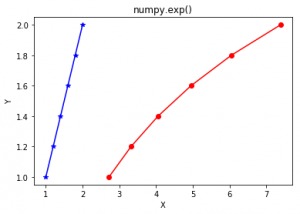numpy.exp(array,out = None,where = True,cast ='same_kind',order ='K',dtype = None):
此数学函数可帮助用户计算输入数组中所有元素的指数。
参数:
array : [array_like]Input array or object whose elements, we need to test.
out : [ndarray, optional]Output array with same dimensions as Input array,
placed with result.
**kwargs : Allows you to pass keyword variable length of argument to a function.
It is used when we want to handle named argument in a function.
where : [array_like, optional]True value means to calculate the universal
functions(ufunc) at that position, False value means to leave the
value in the output alone.
返回:
An array with exponential of all elements of input array.
代码1:工作
# Python program explaining
# exp() function
import numpy as np
in_array = [1, 3, 5]
print ("Input array : ", in_array)
out_array = np.exp(in_array)
print ("Output array : ", out_array)输出:
Input array : [1, 3, 5] Output array : [ 2.71828183 20.08553692 148.4131591 ]
代码2:图形表示
# Python program showing
# Graphical representation of
# exp() function
import numpy as np
import matplotlib.pyplot as plt
in_array = [1, 1.2, 1.4, 1.6, 1.8, 2]
out_array = np.exp(in_array)
y = [1, 1.2, 1.4, 1.6, 1.8, 2]
plt.plot(in_array, y, color = 'blue', marker = "*")
# red for numpy.exp()
plt.plot(out_array, y, color = 'red', marker = "o")
plt.title("numpy.exp()")
plt.xlabel("X")
plt.ylabel("Y")
plt.show() 输出:

参考文献:
https://docs.scipy.org/doc/numpy-1.13.0/reference/generated/numpy.exp.html
。
相关用法
注:本文由纯净天空筛选整理自Mohit Gupta_OMG 大神的英文原创作品 numpy.exp() in Python。非经特殊声明,原始代码版权归原作者所有,本译文未经允许或授权,请勿转载或复制。
